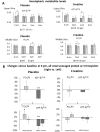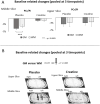Hemispheric asymmetry in high-energy phosphate consumption during sleep-deprivation is balanced by creatine
- PMID: 40520504
- PMCID: PMC12162656
- DOI: 10.3389/fnins.2025.1515761
Hemispheric asymmetry in high-energy phosphate consumption during sleep-deprivation is balanced by creatine
Abstract
The human brain exhibits asymmetric hemispheric activity at night; this plays a crucial role in cognitive impairment from sleep deprivation. Although there have been many investigations on this topic, there are no studies on hemispheric differences in the consumption of high-energy phosphates (HEP). We present here a new data analysis of our previously published study in which subjects were measured for changes in high-energy phosphate (HEP), tCr/tNAA, and Glu/TNAA during subacute sleep deprivation (21 h) and cognitive tests. In our new analysis, we investigated differences and asymmetries in the metabolic consumption of both hemispheres. Comprehensive per-individual voxel-wise interhemispheric comparisons at all time points and conditions showed a greater decrease from baseline of ATP in the right than in the left hemisphere. Partial volume correction yielded an apparent higher decline of PCr/Pi in gray versus white matter. We also investigated whether creatine supplementation, which has been shown to prevent cognitive impairment during sleep deprivation, affected this hemispheric asymmetry. In a second session, the subjects took a high single dose of creatine monohydrate suspension (0.35 g/kg) after baseline measurements. Creatine balanced the sleep deprivation-induced asymmetry to a higher degree in the left hemisphere, which was due to an increase in PCr/Pi and decrease in ATP. Our results confirm-via the observed decrease in ATP level-a night-active right hemisphere. Creatine administration balanced this asymmetry.
Keywords: 31P-magnetic resonance spectroscopy; cognitive performance; creatine; hemispheric asymmetry; high energy phosphate; sleep deprivation.
Copyright © 2025 Gordji-Nejad, Matusch, Kleedörfer, Patel, Drzezga, Elmenhorst, Binkofski and Bauer.
Conflict of interest statement
AD: Research support: Siemens Healthineers, Life Molecular Imaging, GE Healthcare, AVID Radiopharmaceuticals, Sofie, Eisai, Novartis/AAA. Speaker Honorary/Advisory Boards: Siemens Healthineers, Sanofi, GE Healthcare, Biogen, Novo Nordisk, Invicro, Novartis/AAA, Bayer Vital. Stock: Siemens Healthineers, Lantheus Holding. Patents: Patent pending for 18F-PSMA7 (PSMA PET imaging tracer). The remaining authors declare that the research was conducted in the absence of any commercial or financial relationships that could be construed as a potential conflict of interest.
Figures




Similar articles
-
Single dose creatine improves cognitive performance and induces changes in cerebral high energy phosphates during sleep deprivation.Sci Rep. 2024 Feb 28;14(1):4937. doi: 10.1038/s41598-024-54249-9. Sci Rep. 2024. PMID: 38418482 Free PMC article.
-
Multinuclear magnetic resonance spectroscopy of high-energy phosphate metabolites in human brain following oral supplementation of creatine-monohydrate.Psychiatry Res. 2003 Jun 30;123(2):87-100. doi: 10.1016/s0925-4927(03)00046-5. Psychiatry Res. 2003. PMID: 12850248
-
Gray matter-specific changes in brain bioenergetics after acute sleep deprivation: a 31P magnetic resonance spectroscopy study at 4 Tesla.Sleep. 2014 Dec 1;37(12):1919-27. doi: 10.5665/sleep.4242. Sleep. 2014. PMID: 25325507 Free PMC article.
-
Intra- and Inter-hemispheric Connectivity Supporting Hemispheric Specialization.2016 Mar 11. In: Kennedy H, Van Essen DC, Christen Y, editors. Micro-, Meso- and Macro-Connectomics of the Brain [Internet]. Cham (CH): Springer; 2016. 2016 Mar 11. In: Kennedy H, Van Essen DC, Christen Y, editors. Micro-, Meso- and Macro-Connectomics of the Brain [Internet]. Cham (CH): Springer; 2016. PMID: 28590670 Free Books & Documents. Review.
-
Meta-analysis of brain metabolite differences in HIV infection.Neuroimage Clin. 2020;28:102436. doi: 10.1016/j.nicl.2020.102436. Epub 2020 Sep 15. Neuroimage Clin. 2020. PMID: 33383609 Free PMC article. Review.
References
LinkOut - more resources
Full Text Sources
Research Materials
Miscellaneous

